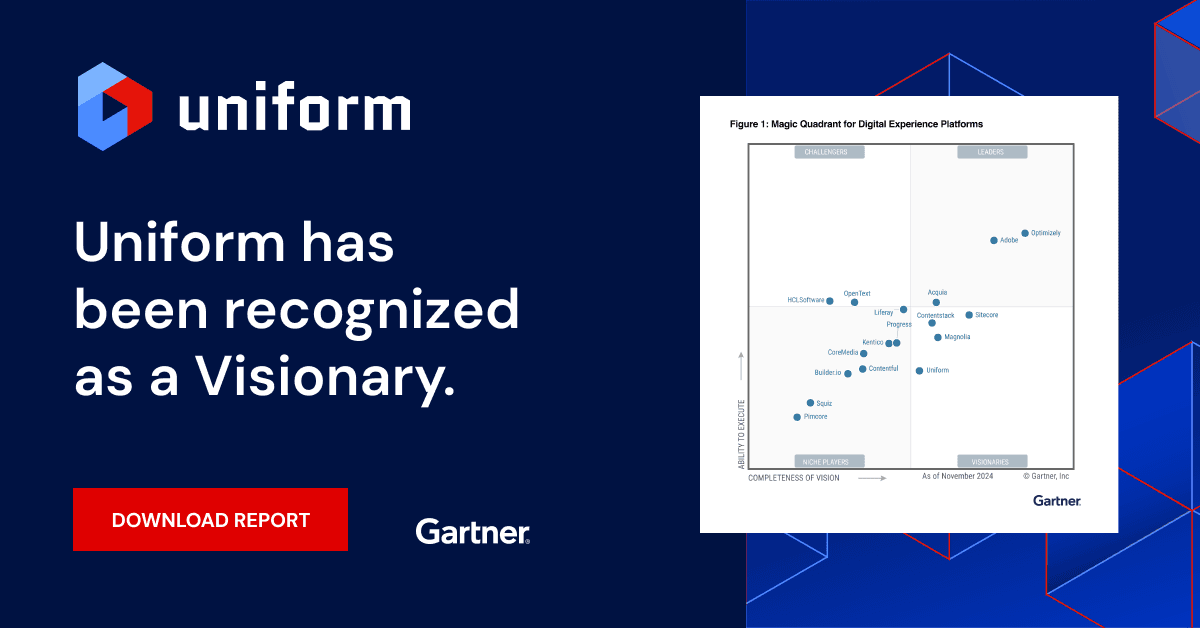Uniform blog/What is composable commerce?
What is composable commerce?
What is composable commerce?
What is composable commerce? It’s a new approach for developing websites and web apps that combines the most robust e-commerce components. Behind the scenes, with companies worldwide supercharging the scalability, agility, innovation, and capabilities of their digital platforms through technologies like headless CMS and microservices, composable commerce was born, positioning itself as the next commerce architecture.
What is composable commerce?
By combining the best elements for creating an engrossing, immersive shopping experience through composable commerce, businesses can optimize their storefront’s speed and technology. Each platform comprises third-party components called Packaged Business Capabilities (PBCs), which are arranged and rearranged in the background as a custom, audience-facing e-commerce platform tailored for a business’s needs.
Composable commerce is paramount because of its impressive functionality. Through an assembly of an ideal platform from third-party vendors, businesses gain a comprehensive e-commerce interface that deftly serves consumers. Plus, instead of praying that a one-size-fits-all platform meets all their needs at scale, businesses can hand-pick components with the exact features they desire.
Understanding composable commerce
For a better understanding of composable commerce, see the analysis below of its concept and that of more conventional architectures.
Composable commerce versus traditional commerce
Here’s how composable commerce differs from traditional commerce:
- The orthodox model is much less flexible than composable commerce, whose structure is inherently modular.
- With vendors’ “plug-and-play” PCBs, businesses can craft a platform that gives them more control over their consumer experience and thus more ease in adapting to consumers’ changing needs through composable architecture.
- Because composable focuses on business, brands can customize their e-commerce platform to meet their needs rather than having to “shoehorn” their unique requirements into an applicable-to-all platform, as they did before.
- Since composable commerce accommodates the desires of businesses and their technical team, the development and innovation process of building an e-commerce platform becomes less risky, ultimately translating to a more compelling and economical experience.
Composable commerce versus headless commerce
Headless versus composable commerce: They are different in the following ways:
- Headless commerce is channel-first, adapting platforms for omnichannel presence through APIs. In contrast, composable commerce is platform-first, building ideal experiences through PCBs.
- Though different in technology, composable commerce wouldn’t have emerged without headless as its predecessor. To achieve the omnichannel presence and adaptability that headless is known for, composable requires your front end (i.e., your store’s features) be detached from your back end (i.e., the components) so that you can construct experiences with the e-commerce tools that appeal to you most—regardless of vendor.
- Headless made plug-and-play possible, enabling businesses to move the key components of their commerce infrastructure across channels and platforms. That freedom was absent in the traditional monolith structure, which housed all store features in a single platform.
For more details on this topic, see our blog Headless versus composable.
Key elements of composable commerce
A composable commerce platform has four key elements, as explained below.
Modular architecture
Thanks to composable commerce’s modular nature, you can quickly and easily incorporate into their infrastructure subsystems, such as search merchandising and recommendations, and swap out elements like the shopping cart or payment options without affecting other systems. You’re free to leave untouched tools directly tied to your system's core components, e.g., the product catalog or inventory-management solutions.
Open configuration
Composable commerce being open spells freedom for businesses so you need to purchase only the systems you need. As you scale, or if a system doesn’t suit you any more, you can easily switch to something else. Such adaptability works for both the vendors and your implementation, making for smooth integrations regardless of the number of vendors.
A caveat is that your system architects must tightly bind the components to the core system, which renders it problematic to transition to other systems in the future, effectively eliminating a key advantage of composable commerce.
Flexibility
Composable commerce’s modular and open nature translates to flexibility with these benefits:
- Being able to interchange components at will and rely on integration partners to provide those components, you can seek out the best offers at the most competitive prices.
- You can focus on generating and delivering the best consumer experience imaginable, in particular the ability to find, buy, and receive your products or services superfast. Given the “new normal” caused by the COVID pandemic, speed is becoming increasingly critical.
Business-centric methodology
By focusing on business, composable commerce affords you the freedom of choosing the components that best meet your needs. What results is a compelling e-commerce experience born fast of cost-friendly development and assembly.
Implementation of composable commerce
Don’t rush the process of implementing composable commerce. Instead, take the proper steps, as follows:
Step 1: Define business goals and tools.
A clear understanding of your business goals is an important first step toward getting the most out of composable commerce. So, list your objectives and prioritize them. Since composable commerce is modular, you need not replace all your platform’s components in one shot. Some tools are an immediate need, but others can wait.
Step 2: Set up your team for success.
To implement composable commerce effectively, you need developers who are proficient in integrating back-end plugins and components with APIs. Provide training if necessary. In addition, collaborate closely with your UX team to ensure that they’re on board and develop a uniform design for all services and components—even the PBCs from third-party vendors.
Step 3: Find the right platform.
Composable commerce can work in several environments, requiring no specific platform. Be sure to, however, adopt a platform that takes composable-friendly design into account and that offers these three crucial capabilities:
- You can launch the platform quickly and easily.
- The platform takes an API-first approach for integrations.
- You’re free to fully explore composable commerce’s flexibility.
In addition, consider these two factors:
- Pricing, which depends on where you are in your business journey. A subscription model might be more ideal for small to medium-sized businesses (SMBs); enterprises might desire something customizable or more robust.
- Customer support, which can be a single point-of-contact (POC) to help you navigate PBCs. Alternatively, set up a POC at each of your vendors.
There’s no right or wrong choice here: Pick whatever is more manageable and appropriate for your infrastructure.
Reasons why businesses are choosing composable commerce
What is composable commerce vis-à-vis benefits to businesses? Here are the major pluses:
- Meeting specific business needs that traditional “master-key” platforms can’t.
- Adapting quickly to meet the evolving market and audience requirements.
- Offering an outstanding e-commerce experience like no other.
To find out how Uniform can help your business achieve the above and set you on a course for e-commerce excellence, schedule a free demo.
No. Here are their differences:
- As a technology slated for composable commerce, headless renders back-end systems independent from their front-end interfaces. As a result, developers can connect the e-commerce tools of their choice to any platform with APIs.
- Composable is a development approach of selecting best-of-need commerce components and grouping or “composing” them through Packaged Business Capabilities (PBCs) into a custom application to meet specific business needs.





.png&w=1080&q=90)
.png&w=1080&q=90)
.png&w=1080&q=90)